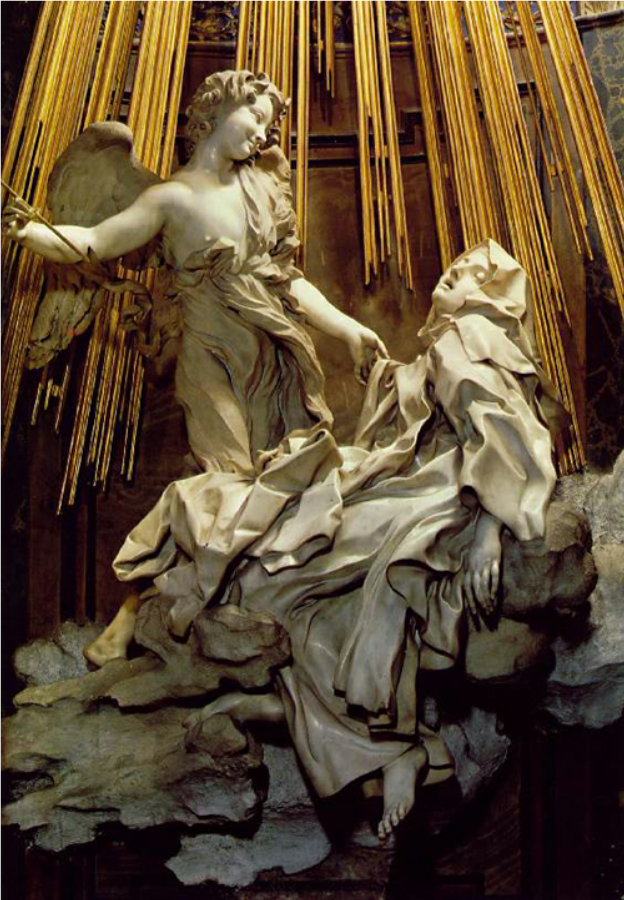
Padre Pio had wounds on the hands and feet, on the left side of the chest, and on the right shoulder were Jesus carried the Cross.
He also had transverberation of the heart, wounds from scourging, and an invisible crown of thorns.
All of them were very painful.
August 5, 1918 TRANSVERBERATION of the heart of Padre Pio.
Transverberation is a spiritual wounding of the heart, as a reward by God for loving Him.
Several saints experienced it. Some few names: Theresa of Avila, Therese of Lisieux, Veronica Giuliani, Marguerite Marie Alacoque, Gerardo Majella,
Joseph of Cupertino, Francis de Sales, Philip Neri, Jane Francis de Chantal, Lutgarde, Charles of Sezze.

Transverberation of St. Teresa of Avila, by Bernini
Padre Pio about the Transverberation, reported under obedience:
"On August 5, 1918 "I was hearing the confessions of the boys, when a Celestial Being holding a steel sword
with a sharp flaming point, hurled it into my soul with all his might.
All done in a split of a second everything in my inside was lashed by fire and steel.
From that moment on I feel an open wound which causes me to suffer continual agony."
On September 20, 1918 Padre Pio received the Stigmata, The Wounds, while praying in the choir.
The stigmata are the bodily wounds on the hands, feet and side corresponding to those inflicted on Jesus at the Crucifixion.
Notable stigmatics were Francis of Assisi, Rita of Cascia, John of God, Gemma Galgani, Veronica Giuliani, Catherine of Siena.
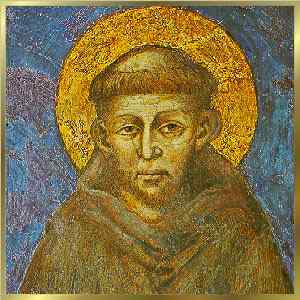
St. Francis of Assisi spent 22 years of intense youthfulness and 22 years of supreme mysticism.
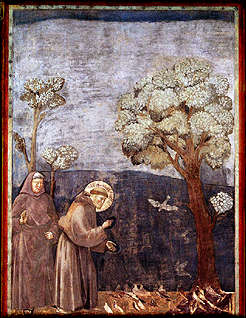
Saint Francis was not a priest. He was a deacon.
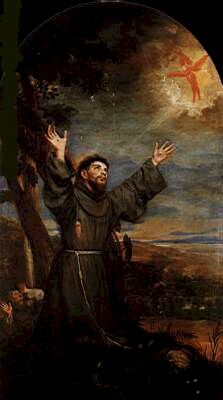
St. Francis of Assisi had the stigmata. St. Francis was the first person to bear the wounds of Christ's Passion.
The wounds were given to him by a Seraph, while he was in prayer, on Mount Alverna. He was 42
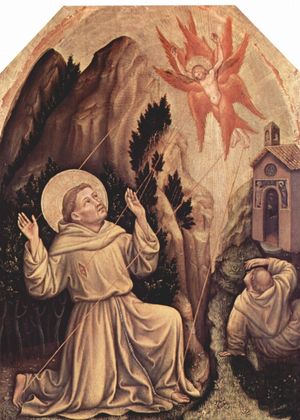
St. Francis' side wound was on the right of the chest. Padre Pio's was on the left, were the heart is.
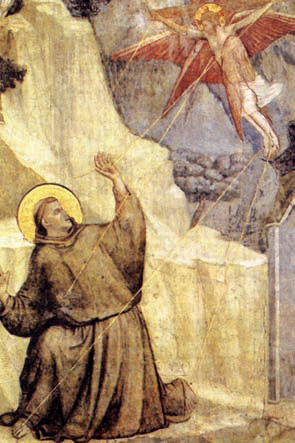
St. Francis had the wounds for two years. Padre Pio had the wounds for 58 years.
St. Francis of Assisi died at 44 on October 3, 1226.
On September 20, 1918 Padre Pio received the permanently visible Wounds, In San Giovanni Rotondo.
In reality he had received the Wounds years before.
On the afternoon of September 7, 1910, few weeks after being ordained priest,
while he was praying in Piana Romana, Jesus and Mary appeared to him and gave him the wounds.
Piana Romana is a hill 3 miles North-East of Pietrelcina were Padre Pio used to pray in the shade of a straw hut, built under an elm tree.
The straw hut has become a church, and the stump of the elm is preserved inside the church.
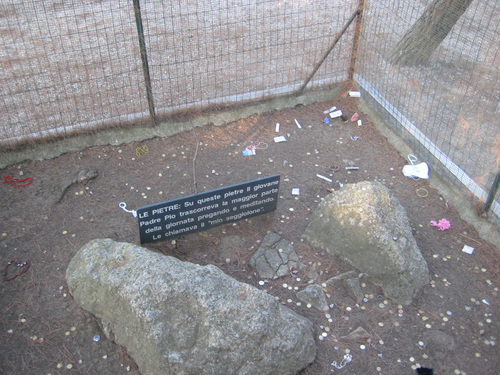
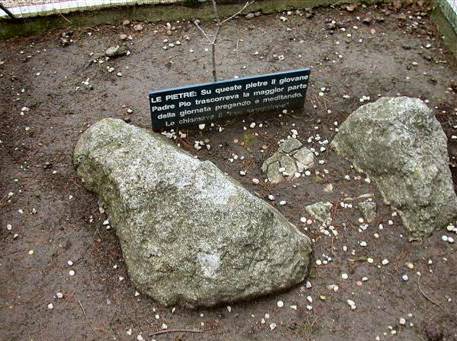
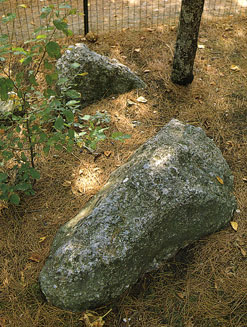
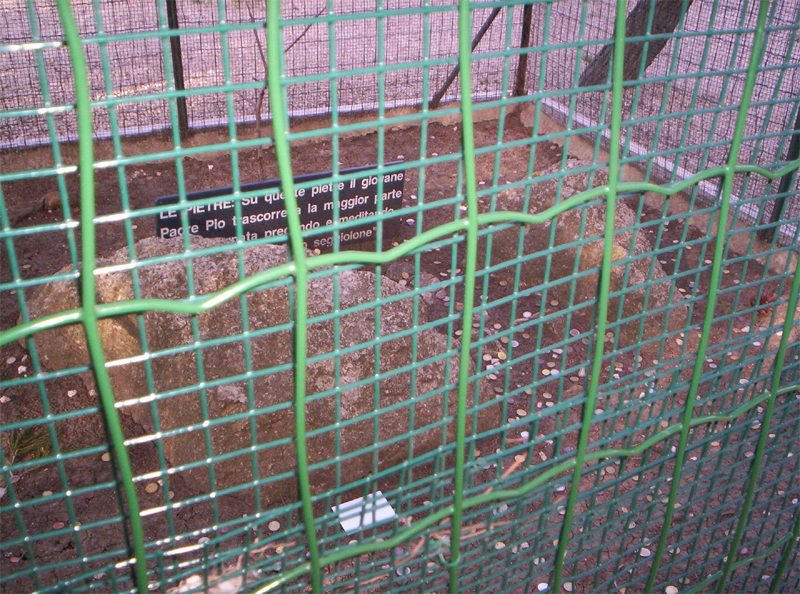
The seggiolone (big chair, high chair)
Padre Pio used to sit or kneel on these two stones praying and meditating many hours every day.
They are near the elm were he received the invisible wounds in 1910.
Mercurio Scocca, friend of family, when Padre Pio left for San Giovanni Rotondo, took care of the area.
He tried to remove the stones, chaining them and pulling with a tractor, to no avail.
Months later he went to visit Padre Pio.
"Man, take care of your things and leave alone the 'seggiolone. "What is the seggiolone?'
"The seggiolone are those stones near the elm. Leave them there. They stay well were they are now."
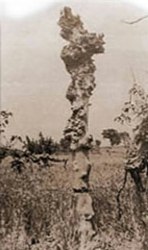
The elm was reduced to a stump by the faithful cutting pieces of it as souvenir.

Here is what it's left of it.
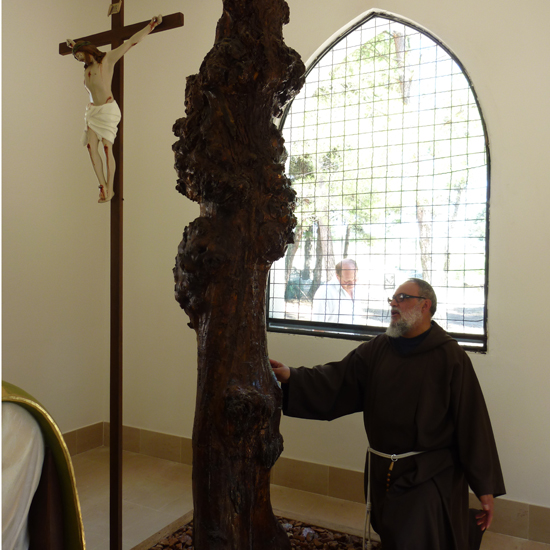
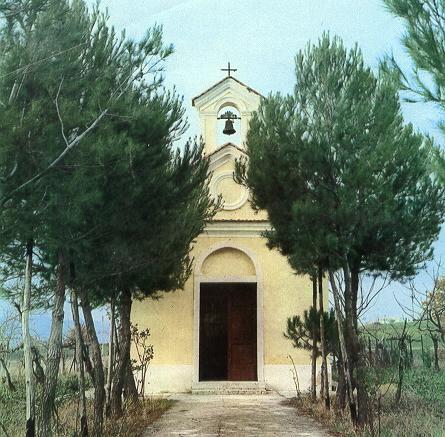

The elm tree preserved in Piana Romana; and the small church containing the preserved elm.
There Padre Pio received the wounds. "Jesus has been there. All has happened there."
The wounds disappeared but the pain never subsided. Padre Pio considered always September 7, 1910, the date he received the wound.
Salvatore Pannullo, pastor of the Parish in Pietrelcina testified that in that afternoon of September 7, 1910
Padre Pio showed him the wounds and told him :
"Father, do me a favor. Ask Jesus to take them away. I want to suffer, to die from suffering, but in secret."
They prayed together, and God answered their prayer. The wounds disappeared and the suffering continued.
When Pannullo was told in 1918 that the wounds had appeared on Padre Pio, he replied: You see them now. I saw them in 1910."
In a letter to Padre Benedetto, his spiritual director, dated September 8, 1910, he wrote:
"Yesterday evening some red spots appeared in the middle of my hands with sharp pain."
Padre Pio received the visible stigmata on September 20, 1918, while praying after celebrating Mass. He was 31 years old.
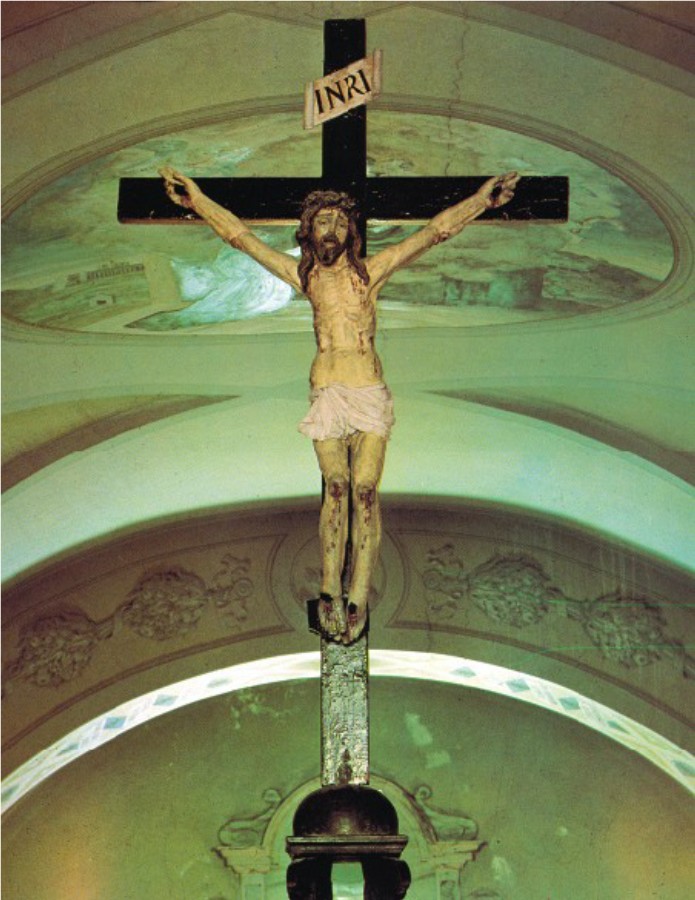
The Crucifix from which Padre Pio received the Stigmata, is located in the choir loft of the small original church.
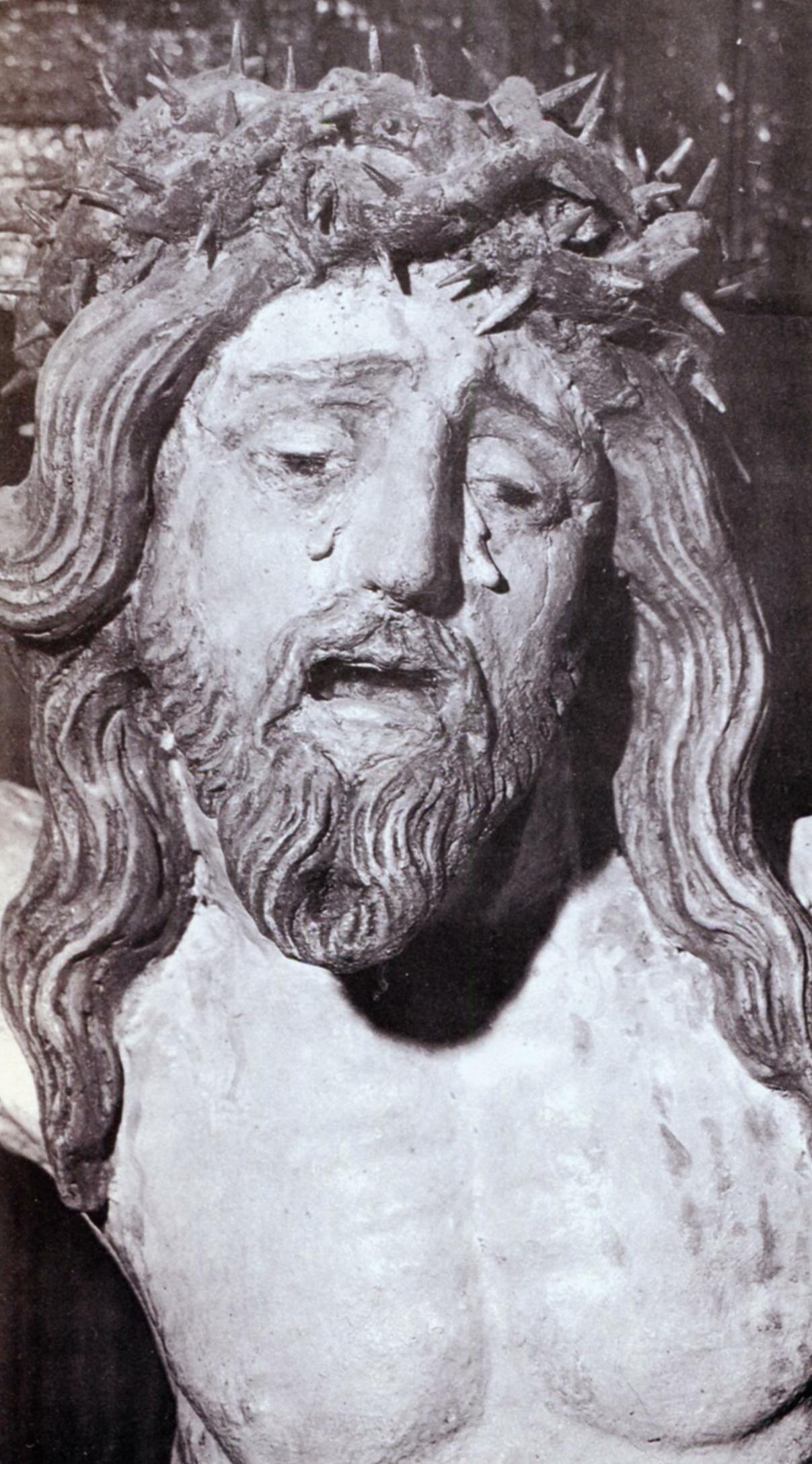
Padre Pio reported under obedience:
"Suddenly I was wrapped in a sea of blazing light.
In that light I saw Jesus. He was very beautiful.
From his wounds came rays of very bright white light that penetrated my hands, my feet, my side.
They were like blades of fire that penetrated my skin piercing, cutting, breaking.
I felt that I would die. The pain was immense."
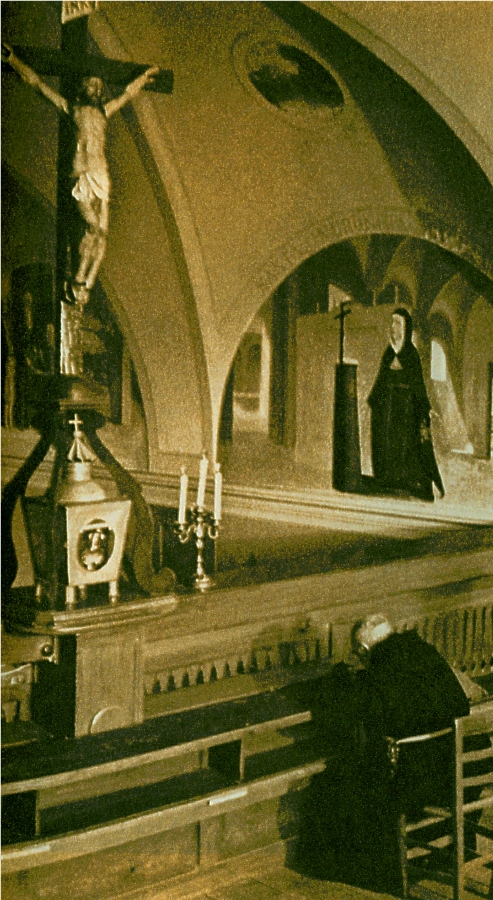
Father Joseph reports: "For nine days nobody knew anything about it.
Than, when the friar changing the linen on his bed found blood on the sheets,
he told the father guardian, and Padre Pio had to confess to what had happened."
.jpg)
.jpg)
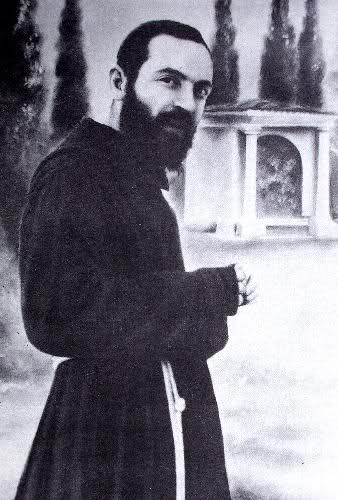
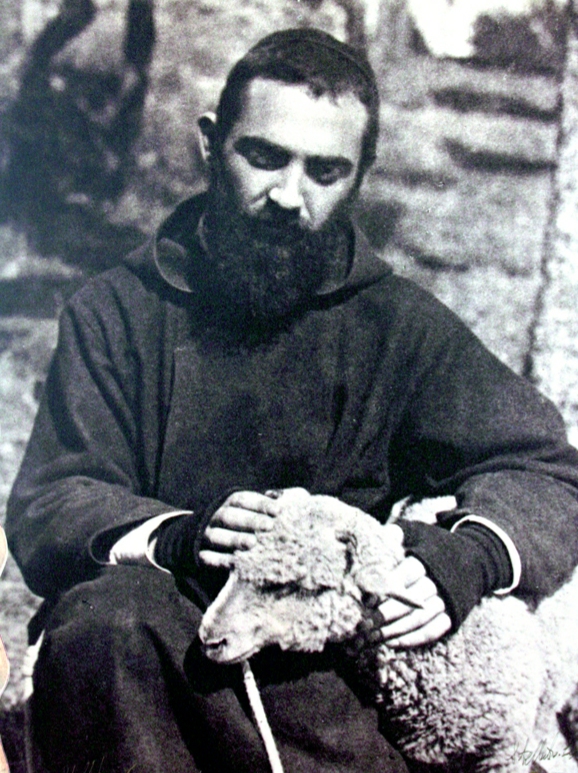
Padre Pio used to cover the wounds with half gloves that would leave his fingers free.
Some medical doctor and prelates inspected the wound by order of Padre Pio's Superiors, the Holy Office, and the Pope.
Doctors Angelo Maria Merla, Luigi Romanelli, Amico Bignami, Giorgio Festa, Giuseppe Bastianelli, Agostino Gemelli;
Archbishop Kenealy, Archbishop Bonaventura Cerretti, Bishop Raffaello Carlo Rossi, Cardinal Silj.
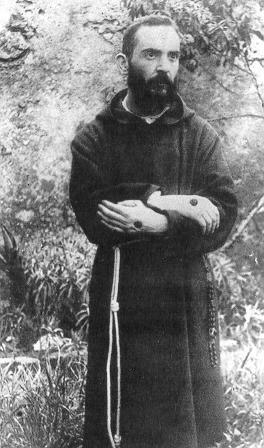
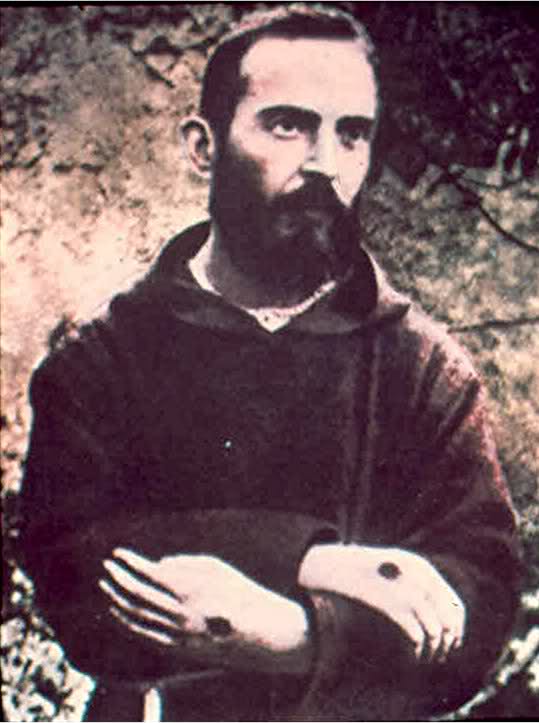
Padre Pio never let anybody look at the wound, except under holy obedience
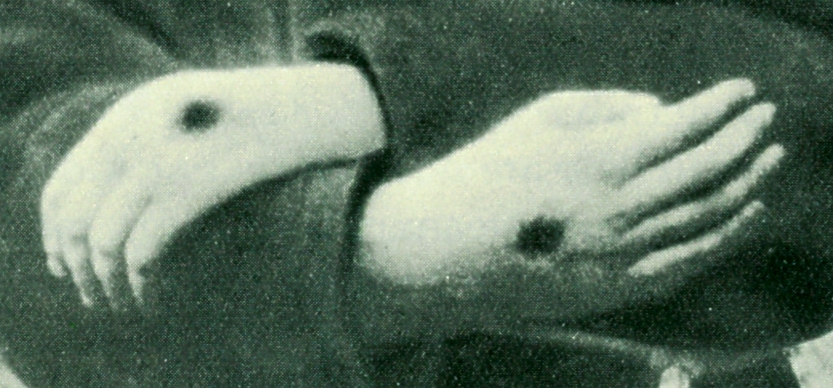
The pictures of the hands were taken under obedience by Padre Placido Bux di San Marco in Lamis
On May 1, 1919 dr. Angelo Maria Merla, was the first one, by disposition of Padre Pietro da Ischitella, Father Guardian Superior of the convent of San Giovanni Rotondo.
Dr. Luigi Romanelli, head surgeon of the hospital in Barletta, examined Padre Pio 5 times between May 15,1919 and July 1920
by disposition of Padre Benedetto di San Marco in Lamis, Provincial Superior of the Capuchins.
"The lesions on the hands are covered by a red brown membrane, without bleeding, no edema and no inflammation of the surrounding tissues.
I am certain that these wounds are not superficial because, putting my thumb in the palm of the hand,
and the index finger on the back, and applying pressure, I have the exact perception of a void existing."
"The etiology of the lesions of Padre Pio is not natural.
The agent producing those lesions needs to be searched, make no mistakes, in the supernatural.
The fact in itself it's a phenomenon that cannot be explained with the sole human science."
Prof. Amico Bignami, professor of medical pathology at the University of Rome, examines Padre Pio on July 12, 1919,
upon request by Padre Giuseppe da Persiceto, General Procurator of the Capuchin Order.
"The lesions on the hands, feet and side can be explained as unconsciously self produced by autosuggestion,
and kept artificially with repeated applications of tincture of iodine."
Prof. Giorgio Festa, examines Padre Pio on 3 occasions. The first on October 28, 1919, upon request by Padre Venanzio da Lysle, Superior General of the Capuchin Order.
The second from 9 to 15 of July 1920 together with prof. Luigi Romanelli. The third on September 28, 1925.
Reported by dr. Festa: A colleague of mine asks Padre Pio: "Why the lesions are here and not in other parts of the body?"
Answer: "Why they should have been in other parts of the body and not here?"
April 18, 1920. Padre Gemelli at the Convent. "Padre Pio I came for a clinical exam of your lesions."
"Do you have a written authorization?" "No" "Than I'm not authorized to show them to you."
When Padre Pio received the wounds in 1918, the Pope was Benedict XV.
He had been elected on September 3, 1914. He died January 22, 1922.
Pope Benedict XV sent Archbishop Anselm Edward Kenealy, of Simla, India, who was himself a Capuchin and a prelate. He examined Padre Pio on March 24-27, 1920:
'I am deeply convinced that we have a true saint here. The Lord has given him great gifts, and he is completely at ease.
If he knows how to suffer, he also knows how to laugh.'
Not completely satisfied, the pope sent archbishop Bonaventura Cerretti to examine Padre Pio.
He too was deeply impressed, and gave the pope a very positive evaluation.
On July 20, 1920 prof. Giuseppe Bastianelli, the personal physician of pope Benedict XV was sent by him to examine the wounds of Padre Pio.
He gave a very favorable report on the case.
1921 investigation
Just revealed In the book 'Padre Pio Under Investigation: The Secret Vatican Files', by Francesco Castelli, Ignatius Press, 2011
IN 1921, bishop of Volterra Raffaello Carlo Rossi,
future cardinal, was sent as secret investigator by the Holy Office.
He started on June 14, 1921, and left after eight
days. Padre Pio was 34 years old.
From his written report:
'Padre Pio is a good religious, exemplary, accomplished in the practice of the virtues.'
"In conversation, Padre Pio is very pleasant; with his brothers, he is serene, jovial, even humorous."
"The religious Community in which Padre Pio lives is a good Community and one that can be trusted."
"The very intense and pleasant fragrance, similar to the scent of the violet, I have smelled it."
"I have examined the monk's cell and could find nothing that would cause such a scent. There was only plain soap."
Padre Pio told Mons. Rossi under oath: "On September 20, 1918 I saw the Lord. I heard this voice: 'I unite you with my Passion.'
Once the vision disappeared, I came to, I returned to my senses, and I saw these signs here,
which were dripping blood. I didn't have anything before."
Mons Rossi: "The stigmata are there: We are before a real fact -- it is impossible to deny."
"I am fully in favor of their authenticity, and, in fact, of their Divine origin."
"The future will reveal what today cannot be read in the life of Padre Pio of Pietrelcina."
Cardinal Augusto Silj, Prefect of Apostolic Signature, visited Padre Pio several times in 1919-1921, each time expressing a very positive opinion.
Countess Virginia Silj-Salviucci reported that Cardinal Silj had told her of an episode happened while he was in a meeting of the Pope Pius XI with several cardinal,
debating about suspending Padre Pio a divinis (meaning from all priestly functions) Padre Pio. While he was speaking, a Capuchin friar appeared,
knelt, and kissed his feet saying "Your Holiness, for the good of the Church, do not take this course of action." He than asked for the Popes' blessing, kissed his
feet again, rose, and left. The pope demanded : "Who let that friar in?" The prelates run outside to upbraid the guards for letting the friar in. All strongly denied having seen any friar.
The Pope grew silent. He ordered Cardinal Silj to ascertain were Padre Pio was that day and hour. Silj investigated, and reported to the Pope that Padre Pio was in the
choir of his friary, saying the Office. Pope Pius XI never mentioned again of suspending Padre Pio from his priestly faculties.
The Pope Pius XI died January 22, 1922
Everybody that had seen the wounds agreed:
The marks appear both in the palm and back of the hands. They are circular and a little more than two centimeters in diameter. They are reddish brown in color and
sharply marked off from the surrounding skin which is perfectly normal and without any sign of inflammation. A dark looking scab covers the wounds, which
detaches itself from time to time. Exactly similar lesions appear in the instep and sole of each foot. The wound in the breast is cruciform, and on the left side.
The bleeding is not periodic, but seems to be a continuous exudation of sanguino-serous fluid from all the wounds especially from the breast.
All this was happening while the Spanish Fever was raging.
During the world pandemic of the of 1918-19, called Spanish Fever, when millions died worldwide, and at least 300 in town,
Padre Pio was in charge of the boys of the Seraphic College at the convent. He asked secretly the sister of a pharmacist in Foggia to supply him
with four milligrams of carbolic acid for disinfecting syringes for injections, Valda pastilles, and other items. He got them.
He must have done a very good job if no deaths were reported in the convent and in the College at the time.
In many letter Padre Pio referred to Spanish fever with sentences like: "You won't be touched" 'She will not be affected"
That family will be spared" "you will recover" "Stay calm, the epidemic will not get you", and so on.
The blood from scourging

Night shirt of Padre Pio showing blood from scourging
Shoulder wound
"The wound that causes me the greatest pain is the shoulder wound. It is painful and sweet at the same time."
In 1947 Karol Wojtyla, asked Padre Pio which of his wounds caused the greatest suffering.
"It is my shoulder wound, which no one knows about and has never been cured or treated."
This undershirt of Padre Pio is preserved in Plexiglas in Padre Pio's original cell #5.
Bloody marks are clearly visible over the right shoulder. Fra' Modestino refers to this undershirt.
At the bottom right there is a certificate of authenticity.
Padre Pio confided to brother Modestino Fucci, that his greatest pains occurred when he changed his undershirt.
Brother Modestino was the doorkeeper at Padre Pio’s friary. On February 4, 1971 Modestino was assigned the task of taking
an inventory of all the items in the deceased Padre’s cell. The same day he discovered that one of Padre Pio’s undershirts
bore a circle of bloodstains in the area of the right shoulder.
On that evening asked Padre Pio in prayer to enlighten him about the meaning of the bloodstained undershirt.
He awakened at 1:00 AM with a terrible, excruciating pain in his shoulder, as if he had been sliced with a knife up to the shoulder bone.
He felt that he would die from the pain if it continued, but it lasted only a short time.
Then the room became filled with perfume of flowers – the sign of Padre Pio’s presence –
and he heard a voice saying "Cosi ho sofferto io!" – "This is what I have suffered!"
Pictures of the wounds:
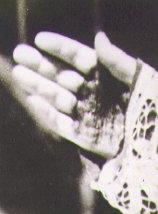
palm of right hand
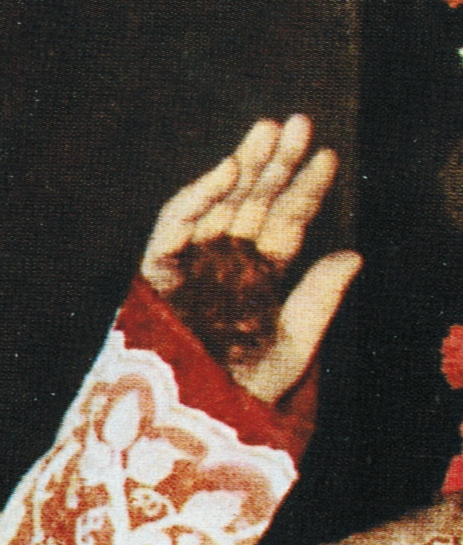
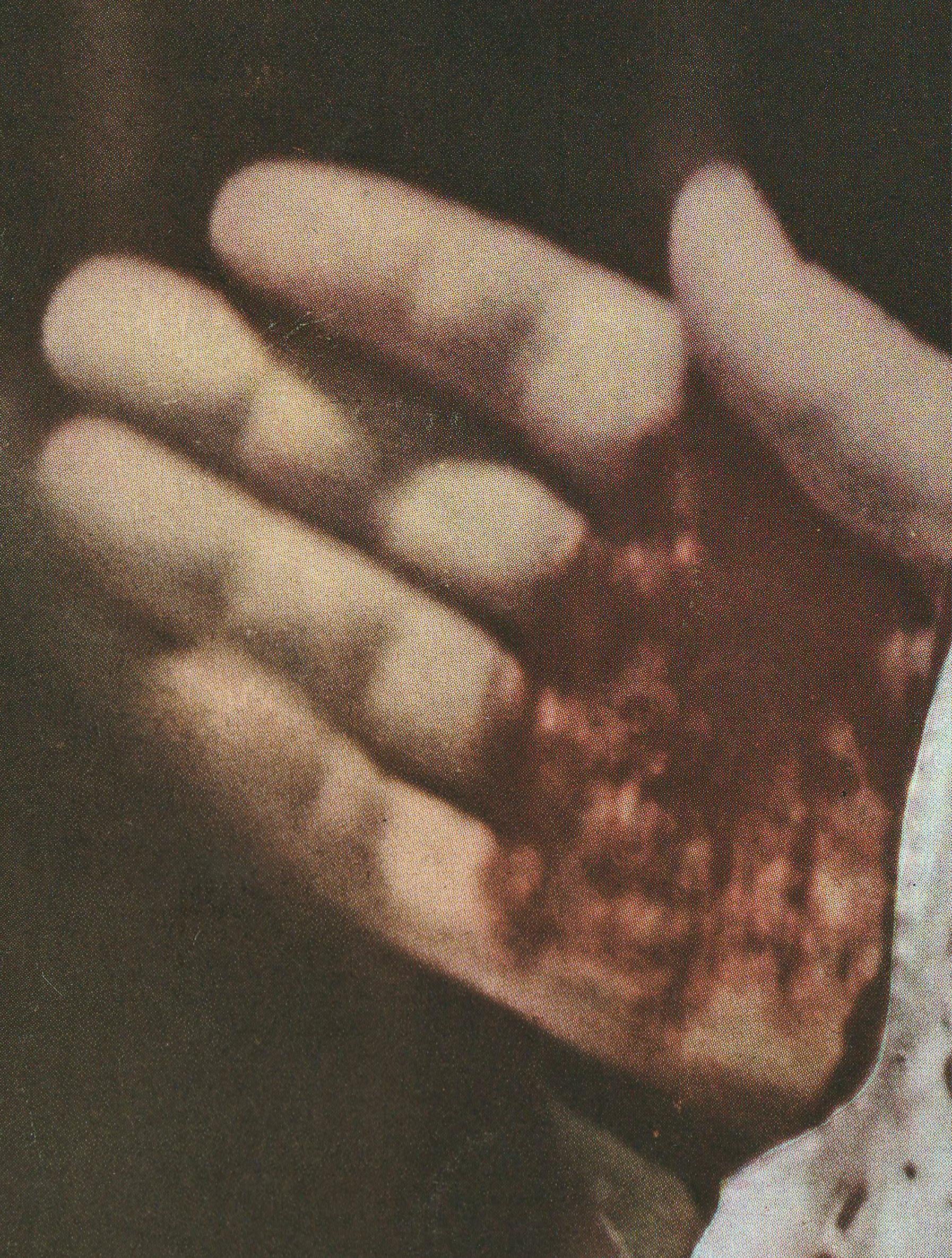
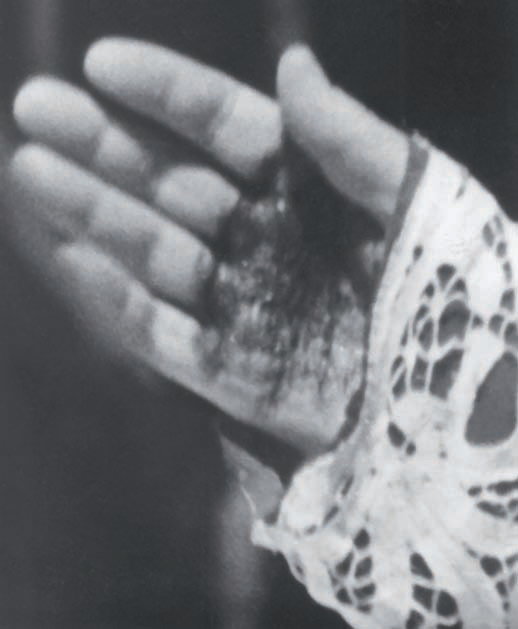
palm of right hand
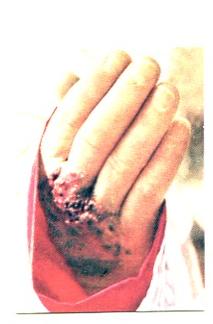
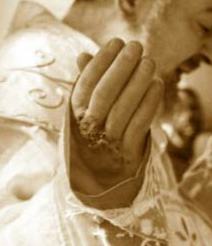
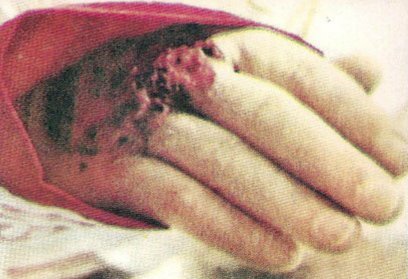
back of right hand

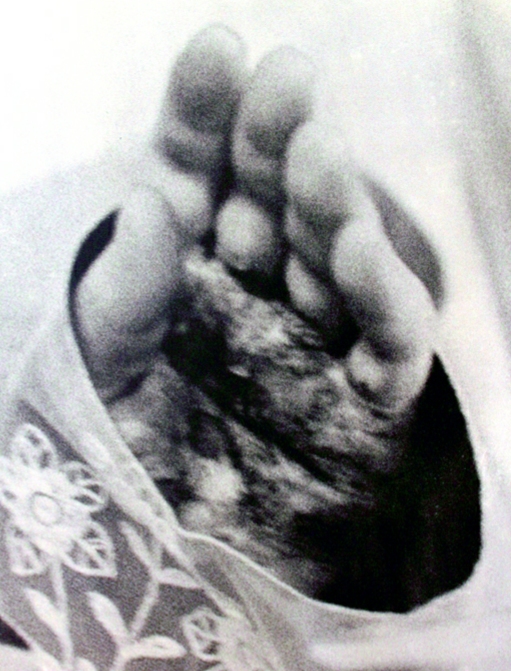
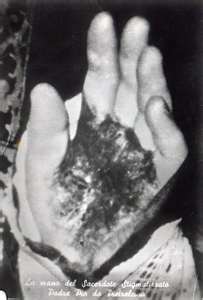
palm of left hand
Next: Close encounters with Padre Pio: The Mass
Close Encounters of the Special Kind with PADRE PIO: hallways, backyard; around the world, ecstasies; Purgatory, Guardian Angel, devil; Americans; confessional, baptisms, first Communions, weddings; Virgin Mary, Rosary; Wounds; Mass; himself, God, Jesus, Cross, Christmas, Church; spiritual children, meditation, prayer, Prayer Groups; child, novice, priest, soldier, fevers; first inquisition, Saint Mary of the Graces, Home for the Relief of Suffering (Casa Sollievo della Sofferenza); the most famous picture, children, blessings, at the ballots downtown, eating; second inquisition, last ten years, death; the Capuchin friars; entombed in first resting place, blessed, saint, exhumed, displayed, final resting place in golden crypt; mosaics of the life of Padre Pio, Jesus, Saint Francis of Assisi; fists class relics with certificates; original painting, original icon.